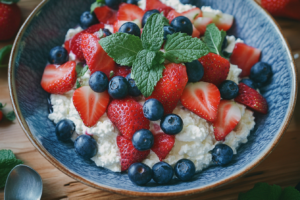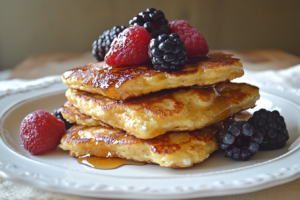Introduction
Cottage cheese has recently gained popularity, especially among beginners looking for nutritious, easy-to-prepare foods. If you’re new to it, you might wonder, how do you eat cottage cheese for beginners? With its high protein content, creamy texture, and versatility, cottage cheese offers countless ways to enjoy it, whether as a light snack or an ingredient in recipes. In this guide, we’ll dive into the many ways beginners can savor cottage cheese, from pairing it with fruits and vegetables to using it in delicious, healthy meals. Let’s explore how to make the most out of this nutritious food!
What is Cottage Cheese?
Explanation and Background
Cottage cheese is a mild, soft cheese made from curdled milk. Unlike many other cheeses, it retains some whey, which gives it a creamy and moist texture. The cheese comes in various curd sizes, from small to large, allowing you to pick the one that best fits your taste. Interestingly, cottage cheese is low in calories yet packed with essential nutrients, making it a fantastic choice for anyone focused on healthy eating.
Why Cottage Cheese is a Great Choice for Beginners
So, why should beginners consider adding cottage cheese to their diet? For one, it’s incredibly versatile. You can enjoy it solo, or add it to smoothies, salads, and even baked goods. It’s also rich in protein, which can help keep you full and energized. And the best part? Cottage cheese is affordable, widely available, and has many low-fat and flavored options to cater to different preferences.
For those just starting with cottage cheese, choosing the right type can make all the difference. Generally, cottage cheese comes in regular, low-fat, and fat-free varieties, each offering a unique texture and taste.
Understanding the Basics
What Does Cottage Cheese Taste Like?
Cottage cheese has a unique, mildly tangy flavor that might take some getting used to. The taste often depends on the type you choose—whole milk cottage cheese is richer and creamier, while low-fat or fat-free versions can be a bit drier or tangier. Texture-wise, cottage cheese can range from small curd to large curd, so you may want to try a few varieties to find the one you enjoy most. Adding it to other foods can help beginners ease into its distinct taste.
Types of Cottage Cheese
Cottage cheese isn’t one-size-fits-all, and that’s good news for beginners looking to explore. You can find options in grocery stores that vary in fat content, curd size, and even flavor. Here are the most common types you might come across:
- Regular Cottage Cheese: Made from whole milk, this type is rich and creamy, giving a satisfying mouthfeel.
- Low-Fat Cottage Cheese: A popular option for those watching their calorie intake, low-fat versions offer a balanced texture while cutting down on fat.
- Flavored Cottage Cheese: Some brands now offer pre-flavored options, like herb, fruit, or vanilla cottage cheese, which can be an excellent choice if you’re just starting and want to mask the tanginess a bit.
Choosing a type that matches your preferences is key to making cottage cheese a go-to choice in your diet.
How to Eat Cottage Cheese for Beginners
1. Eating Cottage Cheese on Its Own
For those new to cottage cheese, starting with it plain is a simple way to introduce this food into your diet. Many people enjoy it just as it is, especially when paired with a sprinkle of salt and pepper. If you want to go beyond the basics, adding a dash of smoked paprika, chili flakes, or even a bit of honey can enhance its taste without overpowering it. Cottage cheese’s natural creaminess makes it easy to eat alone, so beginners can gradually adjust to its texture and flavor.
2. Pairing Cottage Cheese with Fruits

One of the most beginner-friendly ways to eat cottage cheese is by pairing it with fresh fruits. The combination of sweet fruits with tangy cottage cheese creates a delightful contrast that appeals to the taste buds. Here are a few fruit pairings to try:
- Berries (Strawberries, Blueberries, Raspberries): These add a burst of sweetness and a good amount of antioxidants.
- Bananas: Perfect for adding natural sweetness and creaminess.
- Pineapple or Mango: These tropical fruits blend well with cottage cheese’s tanginess.
Adding fruits can make cottage cheese feel more like a treat than a healthy snack, which is perfect for beginners. You’ll get an extra boost of vitamins and minerals along with the protein-rich cottage cheese.
3. Cottage Cheese with Vegetables

For a savory twist, try mixing cottage cheese with fresh or roasted vegetables. This option can be a great afternoon snack or light meal. Here are some vegetables that complement cottage cheese:
- Cucumbers and Cherry Tomatoes: Crisp and refreshing, these make a light, hydrating snack.
- Bell Peppers: Their sweetness pairs well with the creamy texture of cottage cheese.
- Avocado: Adding avocado makes this snack extra creamy and provides healthy fats.
This veggie combination is not only delicious but also enhances the fiber content, making it a great choice for those looking to stay full and satisfied.
4. Incorporating Cottage Cheese in Smoothies
If you’re hesitant about the texture of cottage cheese, blending it into a smoothie can be a perfect solution. Cottage cheese adds creaminess and a boost of protein to any smoothie without an overpowering taste. Here’s a simple smoothie recipe to try:
Berry Cottage Cheese Smoothie
- 1/2 cup cottage cheese
- 1 cup mixed berries (frozen or fresh)
- 1/2 banana
- 1 cup almond milk or any milk of your choice
Blend until smooth, and enjoy! Smoothies are an easy way to enjoy cottage cheese without focusing on its texture, which can be a bonus for beginners adjusting to this food.
Creative Ways to Enjoy Cottage Cheese for Beginners
1. How to Eat Cottage Cheese as a Dip or Spread
One of the best beginner-friendly ways to eat cottage cheese is to turn it into a dip or spread. This option is perfect if you’re wondering how to eat cottage cheese in a way that’s both simple and tasty. Cottage cheese’s creamy texture makes it an excellent substitute for traditional dips like hummus. Here are two easy ideas:
- Herbed Cottage Cheese Dip: Mix cottage cheese with fresh herbs such as dill, parsley, and chives. Add a squeeze of lemon, salt, and garlic powder for flavor. It’s a great snack idea if you’re just learning how to eat cottage cheese for beginners.
- Spicy Cottage Cheese Spread: Add hot sauce, chopped green onions, and smoked paprika to cottage cheese. This spread goes well with whole-grain crackers or veggie sticks, making it ideal for beginners eating cottage cheese.
By using cottage cheese as a dip or spread, beginners can enjoy it with different textures and flavors, which makes it easier to incorporate this nutritious food into daily snacks.
2. Using Cottage Cheese in Baking and Cooking
For those looking for unique ways to incorporate cottage cheese, try using it in baked goods or savory dishes. Cottage cheese is excellent for adding moisture and creaminess, which is a good option if you’re learning how to eat cottage cheese for beginners. Here are a few ideas:

- Cottage Cheese Pancakes: Blend cottage cheese with oats, eggs, and vanilla for protein-packed pancakes. These are great for breakfast and can help beginners enjoy eating cottage cheese without focusing on its texture.
- Cheesy Vegetable Casserole: Combine cottage cheese with veggies, shredded cheese, and seasoning for a delicious, comforting casserole.
Cooking with cottage cheese is a fantastic way for beginners to integrate this protein-rich food into familiar recipes.
3. Making Cottage Cheese Bowls for Beginners
If you’re wondering how to eat cottage cheese in a versatile way, try cottage cheese bowls. Just like smoothie bowls, cottage cheese bowls let you add your favorite toppings. These are easy and customizable, making them great for beginners learning how to enjoy cottage cheese. Here are two bowl ideas:
- Sweet Cottage Cheese Bowl: Add fresh berries, banana slices, honey, and granola to a bowl of cottage cheese. This bowl is perfect if you’re new to eating cottage cheese and want something sweet.
- Savory Cottage Cheese Bowl: Top cottage cheese with cherry tomatoes, cucumber slices, avocado, and a sprinkle of seasoning for a satisfying savory bowl.
These bowls are packed with nutrients, ideal for those trying out how to eat cottage cheese for beginners in different forms.
4. Adding Cottage Cheese to Salads
If you’re exploring how to eat cottage cheese, try adding it to your salads. Cottage cheese pairs well with leafy greens, grains, and other salad ingredients, making it a natural fit for a balanced, high-protein meal. Here’s how:
- Green Salad with Cottage Cheese: Start with a base of mixed greens, add sliced tomatoes and cucumbers, and finish with a scoop of cottage cheese. Drizzle with olive oil and balsamic vinegar.
- Grain Bowl with Cottage Cheese: Use quinoa or farro as a base, add chopped veggies, and top it off with cottage cheese for an extra protein boost.
Adding cottage cheese to salads provides texture, protein, and flavor, helping beginners discover how to eat cottage cheese in new and delicious ways.
Health and Nutrition Benefits of Cottage Cheese
Protein Content in Cottage Cheese and Its Benefits
If you’re curious about how to eat cottage cheese for beginners, it’s worth understanding its nutritional benefits, especially its high protein content. Cottage cheese is naturally packed with protein, making it a great option for anyone looking to feel fuller longer. For beginners, this high protein content is especially helpful, as it supports muscle health, keeps hunger at bay, and stabilizes blood sugar levels.
Calcium and Other Key Nutrients in Cottage Cheese
Another reason to consider cottage cheese is its calcium content, which plays a crucial role in bone health. Besides protein and calcium, cottage cheese provides essential nutrients like vitamin B12, phosphorus, and riboflavin. These nutrients support everything from energy levels to cell health. By learning how to eat cottage cheese regularly, beginners can easily add these beneficial nutrients to their diet.
Comparing Cottage Cheese with Other Dairy Products
If you’re exploring dairy options, you might wonder how cottage cheese stacks up against other choices like yogurt, ricotta, or cream cheese. Cottage cheese has a unique advantage due to its high protein content and relatively low calories, especially if you opt for low-fat versions. Unlike some cheeses, cottage cheese is lower in fat, which makes it ideal for weight-conscious beginners learning how to eat cottage cheese. Yogurt may offer probiotics, but cottage cheese shines with its texture and versatility in both savory and sweet dishes.
Cottage cheese’s health benefits make it a valuable addition to any diet, particularly for beginners interested in healthy eating and adding variety to their meals. By incorporating cottage cheese into various dishes, you can enjoy its rich nutritional profile in a way that fits your taste and dietary goals.
Tips for Beginners on How to Eat Cottage Cheese
How to Choose the Best Cottage Cheese for Your Taste
For those new to cottage cheese, choosing the right type can significantly impact how much you enjoy it. Many varieties exist, from full-fat to fat-free, and even flavored options. Here are some tips to guide beginners on how to eat cottage cheese by finding the best one for their preferences:
- Fat Content: Full-fat cottage cheese is richer and creamier, while low-fat and fat-free versions have a lighter taste. Beginners may prefer starting with regular cottage cheese to fully enjoy its creamy texture before experimenting with lower-fat options.
- Curd Size: Cottage cheese comes in both small and large curd sizes. If you’re adjusting to the texture, small curds might be easier for beginners to enjoy.
- Flavored vs. Plain: Some brands offer flavored varieties like fruit-blended or vanilla cottage cheese. These can be a good option if you’re looking for ideas on how to eat cottage cheese without the tangy, plain flavor.
Selecting the right cottage cheese helps beginners create a positive eating experience, making it easier to enjoy and incorporate into regular meals.
Storage and Shelf Life of Cottage Cheese
To ensure your cottage cheese stays fresh and delicious, proper storage is key. Cottage cheese should be kept in the refrigerator and consumed within 7 to 10 days after opening. Be sure to keep it tightly sealed to maintain freshness. If you notice any sour smell, change in texture, or discoloration, it’s best to discard it. Following these storage tips will allow beginners to confidently enjoy cottage cheese without worrying about spoilage.
Avoiding Common Mistakes When Eating Cottage Cheese
When you’re learning how to eat cottage cheese for beginners, a few common mistakes can make the experience less enjoyable. Here’s what to keep in mind:
- Overmixing: Stirring cottage cheese too much can break down its texture, making it watery. Lightly stir it if necessary to preserve its consistency.
- Adding Too Much Liquid: Cottage cheese already has a creamy base, so be cautious with additional liquids like milk or cream if you’re blending it into smoothies or dips.
- Choosing the Wrong Temperature: Cottage cheese tastes best when served chilled. If you leave it at room temperature for too long, it may lose its appeal, especially for beginners.
Avoiding these simple mistakes can make all the difference in how much beginners enjoy eating cottage cheese. By keeping these tips in mind, you’ll be well on your way to making the most of this versatile, protein-rich food.
Frequently Asked Questions (FAQs)
Is Cottage Cheese Good for Weight Loss?
Absolutely! Cottage cheese is a low-calorie, high-protein food, which makes it ideal for those looking to lose weight. Because of its protein content, it keeps you feeling full for longer periods, reducing the urge to snack on high-calorie foods. If you’re a beginner trying to understand how to eat cottage cheese for weight loss, consider pairing it with fiber-rich fruits or vegetables for a balanced, satisfying snack.
How Do I Make Cottage Cheese Taste Better?
For those who are just starting, eating cottage cheese might feel a bit plain. To enhance its taste, try adding fresh fruits like berries or a drizzle of honey for sweetness. If you prefer savory flavors, mix in some herbs, a pinch of salt, or a sprinkle of black pepper. Experimenting with toppings and mix-ins can make cottage cheese more enjoyable for beginners.
Can Cottage Cheese Be Used in Place of Yogurt?
Yes, cottage cheese can be a great substitute for yogurt in many recipes. It has a similar creamy texture and is also packed with protein. If you’re learning how to eat cottage cheese for beginners, try using it in smoothies, parfaits, or as a topping for granola, much like you would with yogurt.
Is Cottage Cheese Safe for Lactose-Intolerant People?
Cottage cheese contains some lactose, so it may not be suitable for everyone who is lactose-intolerant. However, it typically contains less lactose than milk and other dairy products. Some brands even offer lactose-free options. If you’re exploring how to eat cottage cheese as a beginner with lactose sensitivity, start with a small amount to see how your body reacts.
What are Some Quick Cottage Cheese Recipes for Beginners?
Beginners looking for easy ways to eat cottage cheese have plenty of options. Here are a few quick ideas:
- Cottage Cheese and Fruit Bowl: Add a handful of berries and a drizzle of honey for a sweet, satisfying snack.
- Veggie Cottage Cheese Dip: Mix cottage cheese with diced cucumbers, bell peppers, and a dash of salt for a simple, healthy dip.
- Cottage Cheese on Toast: Spread cottage cheese on whole-grain toast, add avocado slices, and sprinkle with everything bagel seasoning.
These simple recipes provide a starting point for beginners, helping them enjoy cottage cheese in quick, delicious ways.


1 thought on “How do you eat cottage cheese for beginners?”